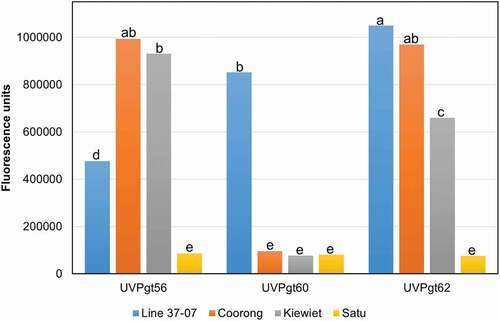Figures & data
Table 1. Origin, status and seedling infection types of the parental genotypes to pathotypes UVPgt56, UVPgt57, UVPgt60 and UVPgt62 of Puccinia graminis f. sp. tritici.
Table 2. Avirulence/virulence formulas for Puccinia graminis f. sp. tritici pathotypes used to determine host response of South African triticales
Fig. 1 (Colour online) Adult plant response types on stems of the triticale cultivars Coorong, Kiewiet, Satu, and the bread wheat variety Line 37–07 (left to right) 16 days post-inoculation, to pathotypes (a) UVPgt62, (b) UVPgt56 and (c) UVPgt60 of Puccinia graminis f. sp. tritici, respectively
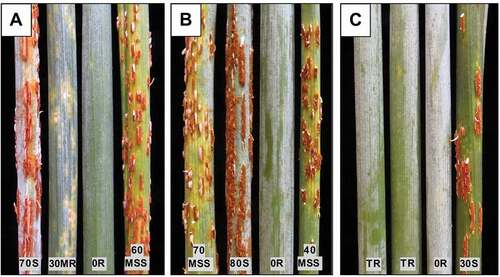
Fig. 2 Scanning electron micrographs of Puccinia graminis f. sp. tritici pathotype UVPgt62 24 or 48 hpi on flag leaf sheaths of (a and d) Coorong, (b, c and e) Satu and (f) Kiewiet, respectively. (a) A germinating urediniospore (24 hpi), (b) formation of a germtube (GT) (24 hpi), (c) formation of an appressorium (A) on top of a stoma (24 hpi), (d) the abstriction from the germtube by a septum (S) (24 hpi), (e) a collapsed appressorium (48 hpi) and (f) the interconnective tube (IT) (24 hpi)
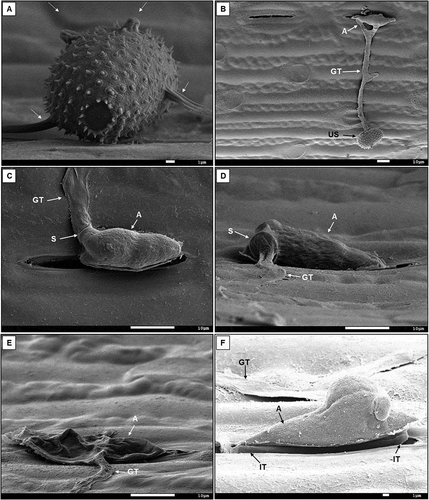
Fig. 3 Scanning electron micrographs of the early penetration process (24 hpi) of Puccinia graminis f. sp. tritici pathotype UVPgt62 on flag leaf sheaths of the stem rust-susceptible variety (a) Line 37–07 (bread wheat), and the resistant triticale cultivar (b) Satu, and the susceptible cultivar Coorong (c, d) indicating the substomatal vesicle (SSV), secondary infection hypha (SIH), detached during preparation of the specimen and the formation of the haustorium mother cell (HMC) with an infection peg (IP)
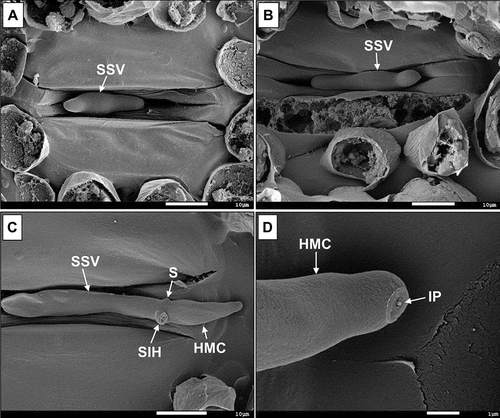
Fig. 4 Scanning electron micrographs showing the development of Puccinia graminis f. sp. tritici pathotype UVPgt62 inside the substomatal cavity of the flag leaf sheaths at 48 hpi on the stem rust-susceptible entries (a) Line 37–07 and (b) Coorong and resistant entries (c) Kiewiet and (d) Satu, respectively. The substomatal vesicle (SSV), haustorium mother cell (HMC), septum (S) and secondary infection hyphae (SIH) are indicated
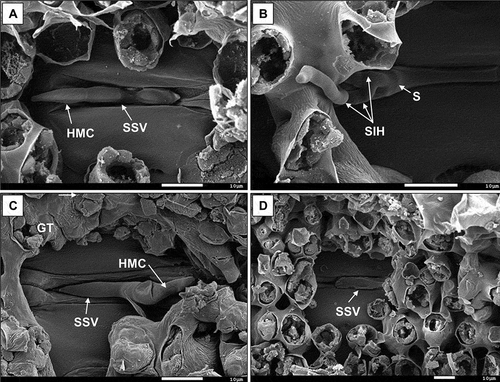
Fig. 5 (Colour online) Microscope images, taken at 120 hpi with Puccinia graminis f. sp. tritici pathotype UVPgt62, showing differences in the size of fluorescing colonies in adult plant leaf sheaths of the stem rust-susceptible entries (a) Line 37–07 and (b) Coorong and resistant entries (c) Kiewiet and (d) Satu, respectively. Images (e) and (f) display the necrotic area associated with a small colony in Kiewiet, (e) on top of the leaf sheath and (f) inside the leaf sheath. Images (g) for the susceptible variety Line 37–07 and (h) for the resistant cultivar Coorong show the comparative leaf sheath penetration process of pathotype UVPgt60. The appressorium (A), germtube (GT), necrotic area (N), substomatal vesicle (SSV) and urediniospore (US) are indicated
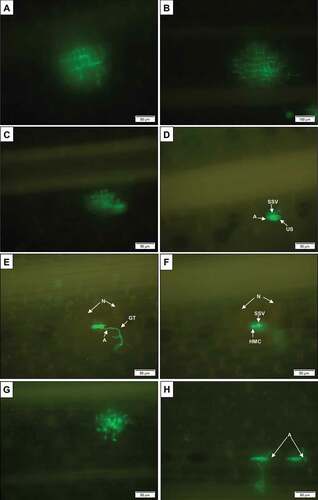
Fig. 6 (Colour online) Average colony sizes (µm2) for pathotypes UVPgt60 and UVPgt62 of Puccinia graminis f. sp. tritici measured 120 hpi in the adult plant leaf sheaths of the susceptible wheat variety Line 37–07 and the triticale cultivars Coorong, Kiewiet and Satu. Least significant differences (LSD) among lines for colony size were calculated as 7497 (P ≤ 0.05), i.e. means with the same LSD symbol do not differ significantly from each other
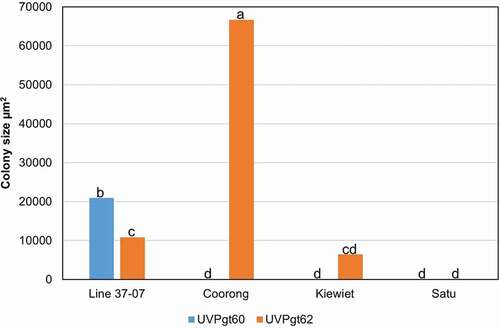
Fig. 7 (Colour online) Quantification of the WGA-FITC probe (wheat germ agglutinin fluorescein isothiocyanate conjugate) bound with fungal chitin for pathotypes UVPgt56, UVPgt60 and UVPgt62 of Puccinia graminis f. sp. tritici measured 16 days post-inoculation for the susceptible wheat variety Line 37–07 and the triticale cultivars Coorong, Kiewiet and Satu. Least significant differences (LSD) among lines for fluorescence measurements were calculated as 101 267 (P ≤ 0.05, supplementary table), i.e. means with the same LSD symbol do not differ significantly from each other
